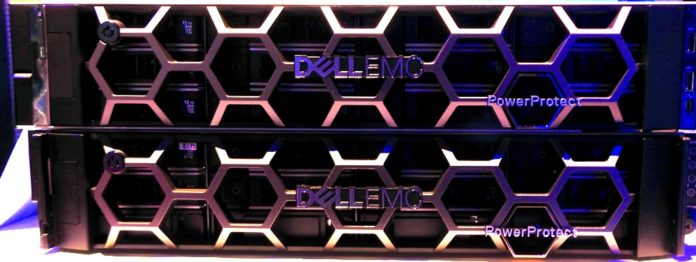Dell Technologies World Dell EMC today announced new PowerProtect data protection hardware and software, along with an entry-level DP440 integrated data protection appliance.
In our opinion, PowerProtect has emerged as Dell EMC’s main integrated data protection appliance range. The PowerProtect software is an alternative to backup software products such as BackupExec and NetBackup, and the X400 appliance competes against target purpose-built back appliance such as a Data Domain system.
The PowerProtect hardware system has direct backup to component capacity nodes to avoid a central controller bottleneck slowing operational speed as the system scales up.
PowerProtect software
The Dell EMC PowerProtect Software is called a platform and provides data protection, replication and re-use. It supports long-term retention in the public cloud and is described as a multi-cloud product.
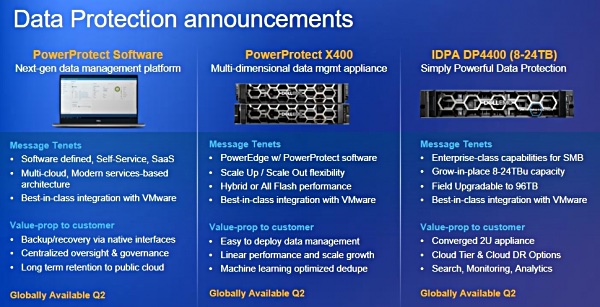
Backed up data and virtual machines data are live mounted by VMs in client servers. The data is used, for example, for database patch testing or some other test and dev requirement.
PowerProtect software can run stand-alone on a server and send protection data to a target backup array, such as Data Domain. Alternatively it can run in the X400 appliance.
Agents
The appliance supports Oracle, Microsoft SQL, VMware, Windows and Linux file systems workloads and users can perform backup and recovery operations from their native applications. Agents are used with the data sources.
These agents run Data Domain Boost source deduplication software, which part-deduplicates the data stream and the target PowerProtect system (Or X400 capacity node) completes the work. This increases the data ingest speed.
The agents also send workload type data to the PowerProtect software which can use this for data placement in the X400 appliance.
The software has SaaS-based management and self-service capabilities that give individual data owners the ability to control backup and recovery operations.
VMware vSphere customers get automated policy-based backup and recovery and integration with vRealize Automation.
There’s a PowerProtect software roadmap and this includes Cloud DR, Office 365 support, multi-tenancy and RST API availability. An in-built deduplication engine could be added to the software.
NAS is not supported, neither is NDMP, or other target devices apart from Data Domain. However, these could be items on the roadmap.
Update: There is a large set of Data Domain Boost agents, larger than the comparatively few that PowerProtect supports in its first release. For example, there are Data Domain Boost agents for Cassandra, MongoDB and Hadoop. It seems readily apparent that PowerProtect could expand ts source application support list by using existing Data Domain Boost agents.
PowerProtect software could also run on the VxRAIL hyper-converged system. The software can run on any VMware-certified server.
PowerProtect X400
The X400 PowerProtect hardware combines PowerEdge servers, with local flash (X400F) or hybrid flash+disk storage (X400H), and PowerProtect software. It can scale-up with capacity expansion and scale-out compute power, capacity and network bandwidth by adding X400 nodes, called cubes in Dell EMC’s vernacular, although as 2U rack enclosures they are not cubic in shape.
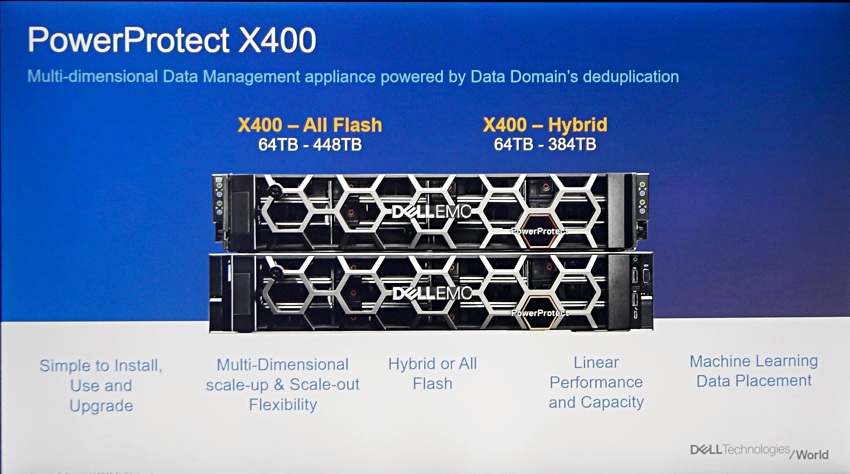
The base appliance configuration is an X400 platform cube (2U) and one to four X400H or X400F scale-out cubes (2U) for capacity. Currently you cannot mix X400F and X400H capacity cubes in a single X400 appliance.
X400H cubes have from 64TB to 96TB of usable capacity, while an X400F cube has from 64TB to 112TB. We don’t know what kind of SSDs are being used.
In-cube capacity expansion is accomplished through a license upgrade as cubes are shipped fully populated.
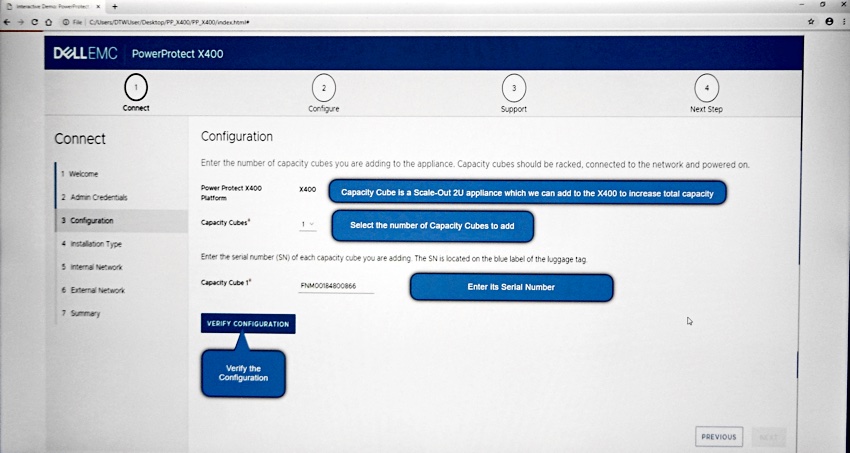
Data is sent directly to the capacity cubes across 10 or 25GbitE links; it not being routed through the base platform cube. The core cube is a management system, a control plane, and not in the data plane.
Data placement in an appliance and its capacity cubes is driven through a machine learning-based load balancing scheme. As scale-out cubes are added the system will rebalance, with data migrated to an appropriate scale-out cube with available resources.
The data placement uses workload characterisation to move data to the appropriate cubes to maximise overall deduplication. Exactly how it decides on data location placement is proprietary information.
If a workload is moved from one cube to another as part of a rebalancing exercise it does not lose its deduplicated state, and the control plane software remaps the incoming source data stream to the new cube without any change being needed on the source system.
Effectively it’s a hyperconverged data protection system that, Dell EMC says, enables users to protect, manage and recover data at scale.
The roadmap includes increasing the number of capacity cubes from 4 to 8 and on to 12.
We might consider the idea of having two fully populated X400s, with 12 capacity cubes each, co-ordinated in some way by a super-controller.
Limited deduplication
The system has built-in deduplication but the scope is limited to single capacity cubes in this first release of the PowerProtect software. It does not have a global scope across the cubes in an X400 appliance or, indeed, across X400 appliances.
Dell EMC said such global deduplication could slow the data ingest speed and that this is undesirable.
Dell EMC logical capacity tables use a 10X to 50X deduplication ratio. For example, Dell EMC suggests an X400 scale-out cube with its 64TB to 112TB of usable capacity, can have a 640TB to 5.6PB logical (deduplicated) capacity. The range is very wide so customers should run proof of concepts at their own sites to find the deduplication ratio they actually experience.
Blocks & Files’ understanding is that global deduplication across the capacity cubes may make it to a a future roadmap.
But the PowerProtect group needs to find out first if this delivers appreciable improvements in the overall deduplication ratio. Also any extra work in co-ordinating deduplication tables between capacity modes should not place too much demand on the system.
Data management
PowerProtect software has some data management, data reuse features, but there is nothing in this first release to cause concern to specialist data management, data analysis, and copy data re-user companied. However this is a possible development direction for Dell EMC if it wants to tackle the likes of Actifio, Cohesity, Delphix, and Rubrik head-on
The X400 has SaaS-based management, compliance and predictive analytics.
The all-flash PowerProtect X400F differs from the Pure Storage FlashBlade product which, although used as an all-flash backup target, is not positioned as a data protection appliance.
IDPA DP4400 low capacity version
Dell EMC has announced the availability of an 8-24TB version of its Integrated Data Protection Appliance (IDPA) DP4400. This is intended for smaller organisations and remote offices and can grow in place up to 96TB with the purchase of license keys and an upgrade kit.
The IDPA systems run Avamar software and are hybrid, flash and disk-based. They overlap the PowerProtect X400H in capabilities, as this IDPA product table shows:
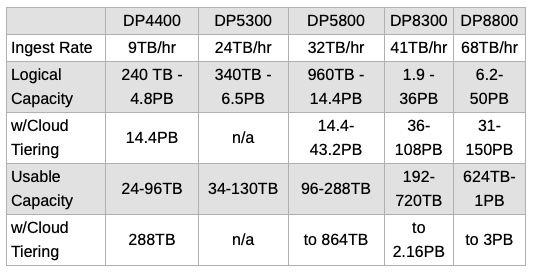
A DP4400 is roughly similar to an X400H chassis. The X400 core platform can scale out to four X400H chassis and 384TB of usable capacity – the same usable capacity range as the DP4400, DO5300 and DP5800. It doesn’t reach the DP8300 and DP8800 capacity levels .
Dell is not positioning PowerProtect as competitor to more complex Avamar/Networker products.
Feel the Power
Dell EMC is consolidating storage, servers and networking brands to single product lines, all with Power branding. The company has already released PowerSwitch networking, PowerEdge servers, PowerMax high-and arrays and PowerVault entry-level arrays.
Blocks & Files thinks that the PowerProtect line will be Dell’s main data protection appliance line going forward and the IDPA product set may diminish in importance over time.
Availability
The PowerProtect Software platform and PowerProtect X400 appliance is generally available in July 2019. The 8-24TB DP4400 is generally available in May 2019.


